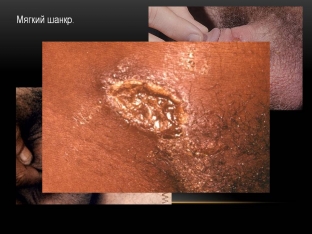Chancroid, or soft chancre, is registered in almost all countries of the world & nbsp; and in a number of regions significantly prevails over other diseases that are sexually transmitted. This venereal infection is acute and painful, develops quite quickly and typically, often combined with HIV, syphilis, and even genital herpes, which can complicate the diagnosis of the disease. A soft chancre equally often and severely affects men and women, but often men get an acute manifestation of the disease, and women – prolonged and completely asymptomatic carriage.
Features of the spread of soft chancre and symptoms of the disease
For the first time, the causative agent of the disease called chancre – stick Haemophilus ducreyi – was described by various researchers at the end of the 19th century. These streptobacilli are quite resistant to chemicals and low temperatures, but if they are affected by heating and even more so by boiling, they quickly die.
This venereal infection is spread mainly through sexual contact, although there are known cases of non-sexual infection of medical workers. The type of sexual contact does not matter, the probability of contracting a chancre after the first contact is about 50%.
Shankroid has a very short incubation period – about a week, but symptoms of infection may appear even a day or two after unprotected sex. At the site of introduction of streptobacilli, a bright red edematous spot appears. In the center of such a spot, a nodule is first formed, and then in its place - a bubble with purulent contents. The chancre itself, that is, a painful ulcer, develops after a few days and has an irregular shape, and the ulceration grows rapidly both in width and in depth. The ulcer is soft, but very painful, bleeds, has an inflamed corolla and a purulent plaque with blood & nbsp; at the very bottom. Purulent discharge from the ulcer, accidentally falling on the surrounding tissues, provokes the appearance of new small ulcerations along the periphery, which can merge into one large creeping ulcer.
Usually, chancre ulcers are located on the genitals, less often in the anus or on the oral mucosa. Extra-sexual manifestations of a soft chancre (for example, among doctors) can occur on the palms, fingers, sometimes patients themselves spread the infection from the affected areas throughout the body.Current of chancre and possible complications
New ulcers with chancre continue to form for about 4 weeks, then they gradually begin to heal, forming small scars. Without timely adequate treatment, a soft chancre can be complicated by damage to blood vessels, lymph nodes, the development of phimosis and paraphimosis.
Among the complications of a soft chancre, it is also possible for the infection to spread along the periphery - from the genital organs, the transfer of ulcers to the thighs, perineum, and pubis. Perhaps the development of a venereal infection deep into – this is its gangrenous variety, which is dangerous with septic phenomena, exposure and destruction of the cavernous bodies, severe bleeding and a long progressive course when large areas are affected.

The main feature of soft chancre is that, unlike most sexually transmitted infections, this disease is easily treatable with antibiotics or sulfonamides. Moreover, if therapy is started at the initial stage of the disease, there are no complicating factors, then the patient's recovery occurs within about 10 days.
Preferably use of antibacterial drugs, the action of which is directed both to streptobacilli and to the causative agent of syphilis. In parallel, topical antibiotics are used to alleviate clinical symptoms, and & nbsp; as well as immunomodulatory drugs. Advanced and complicated cases of chancre may require surgery.
The human body, unfortunately, is not able to develop immunity against streptobacilli, so there is a possibility of re-infection of the patient. With early treatment, the prognosis is favorable.







Add a comment